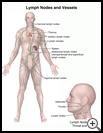
Cervical Adenitis
________________________________________________________________________
KEY POINTS
- Cervical adenitis (lymphadenitis) is inflammation (swelling) of a lymph node in the neck.
- Most cases of cervical adenitis do not require treatment except for close watching. More serious infections caused by bacteria may be treated with antibiotic medicine.
- Ask your child’s healthcare provider how to take care of your child at home, what symptoms or problems you should watch for, and what to do if your child has them.
________________________________________________________________________
What is cervical adenitis?
Cervical adenitis is inflammation (swelling) of a lymph node in the neck. Lymph nodes are small, bean-shaped organs. They are part of the lymph system. One node or a group of nodes can be swollen. The lymph system is part of the body's system for fighting infection. The lymph system consists of lymph nodes that store blood cells (lymphocytes) to fight infection and vessels that carry fluid, nutrients, and wastes between your body and your bloodstream.
Another term for this condition is cervical lymphadenitis.
What is the cause?
Cervical adenitis is common in children. It is usually caused by a viral upper respiratory illness (URI).
Viruses or bacteria in the nose, tonsils, throat, ears, and skin can spread to the lymph nodes and cause an infection. Bacteria may also spread from an infected tooth or from an infection in another part of the body. Cat scratch disease can cause lymph node swelling. Some cancers can cause cervical adenitis.
What are the symptoms?
Symptoms may include:
- Swelling and tenderness of one or more lymph nodes
- Sore or red skin in the area of the affected lymph nodes
- Fever
- Pain when your child swallows
- Pain when your child moves his or her neck
Your child may be unwilling to move his or her neck fully in all directions.
How is it diagnosed?
Your child's healthcare provider will ask about your child's symptoms and medical history and examine your child. Lab tests are usually not needed in children with cervical adenitis.
Your child may have blood tests to look for signs of infection. Your child may have a throat swab. If your child’s node is very swollen or your child has fever, pain, and difficulty moving his or her neck, your child may need:
- An ultrasound, which uses sound waves to show pictures of the lymph nodes
- A CT scan, which uses X-rays and a computer to show detailed pictures of the neck
How is it treated?
Most cases do not need to be treated except for close watching. Your health care provider may watch your child for changes when lymph nodes are small and not red or sore, and when they have been swollen for less than 2 weeks.
Your child may need antibiotic medicine if the lymph nodes are large, when they are on just one side of your child’s body, or if they are red and sore.
More severe infections may need to be treated with IV antibiotic medicine in the hospital. If the infection becomes an abscess (full of pus), the infection may need to be opened and drained.
If there is so much swelling that the infection is pressing on your child’s throat or windpipe, your child may need to stay in the hospital until the swelling has gone down.
How can I take care of my child?
- Encourage your child to drink enough liquids to keep the urine clear to light yellow in color.
- Wash yours and your child’s hands often and especially after using the restroom, coughing, sneezing, or blowing your nose. Also wash yours and your child’s hands before eating or touching the eyes.
- Give your child nonprescription pain medicine such as acetaminophen, ibuprofen, or naproxen. Read the label carefully and give your child the correct dose as directed.
- Nonsteroidal anti-inflammatory medicines (NSAIDs), such as ibuprofen, naproxen, and aspirin, may cause stomach bleeding and other problems.
- Check with your healthcare provider before you give any medicine that contains aspirin or salicylates to a child or teen. This includes medicines like baby aspirin, some cold medicines, and Pepto-Bismol. Children and teens who take aspirin are at risk for a serious illness called Reye’s syndrome.
- Acetaminophen may cause liver damage or other problems. Do not give more doses than directed. To make sure you don’t give your child too much, check other medicines your child takes to see if they also contain acetaminophen. Unless recommended by your healthcare provider, your child should not take this medicine for more than 5 days.
- If your child is given antibiotic medicine, give the antibiotic medicine for as long as your child’s healthcare provider prescribes, even if your child feels better. If you stop giving the medicine too soon, you may not kill all of the bacteria and your child may get sick again. If your child has side effects from the medicine, talk to your child’s healthcare provider.
- If your healthcare provider outlined the lymph node with a pen, tell your provider if the lymph node or redness is growing beyond the markings.
- If the infection was drained, follow your provider’s instructions for taking care of the wound.
- Ask your child’s healthcare provider:
- How and when you will get your child’s test results
- How long it will take for your child to recover
- If there are activities your child should avoid and when your child can return to normal activities
- How to take care of your child at home
- What symptoms or problems you should watch for and what to do if your child has them
- Make sure you know when your child should come back for a checkup.
Last modified: 2022-01-03
Last reviewed: 2019-02-05

